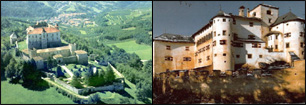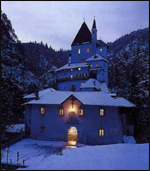|
Green
Holiday: a
dive into nature
The
Region is very rich of vegetal species, which are typical of the
Alpine environment, as the beech, the silver fir, the red-deal,
the larch, the Swiss stone pine tree, the mountain pine, the
rhododendron, the rowan tree, to mention just a few. Fauna is
represented by deer, chamois, roe-deer, hares, eagles, grouses and
other types of this species who find in the valley surroundings
their natural habitat.
For a dive into nature the ideal thing is to visit the two
Parks of Stelvio and Adamello-Brenta.
|
Stelvio
National Park
|
 |
It occupies
a surface of 95,000 ht between the Province of Trento, Bolzano,
Sondrio. Countless are the natural guided itineraries. Pls apply
to the visitors centre of Rabbi Valley (40 km from Sfruz).
Please see as well: http://www.stelviopark.it/
|
Adamello-Brenta
Natural Park
|

|
Set up in
1967, you can access to it from the part of Tovel Lake where
there's a visitors centre. It has a surface of 61,862 ht and
includes almost entirely the Brenta Dolomites and part of Adamello
Presanella . In the Park heart you'll find the enchanting Genova
Valley, where the brown bear till lives today. It's an
independent Board since 1989, regulated and financed by Province
laws.
Please see as well: http://www.parcoadamellobrenta.tn.it/
| Tovel Lake |
 |
It's the
king of the Alpine Lakes in the Park and the natural heart of the
Brenta Dolomites. It's famous for the strong red colour it assumed
until 1964 thanks to the micro-organism 'Glenudinum
Sanguinium", still here in its waters, but in inferior
quantity. It remains anyway one of the most well-known spots
thanks to its extraordinary landscape and natural beauty. The road
to the lake goes through the Brenta Group from Tuenno.
|
|
|
|
The
castles |
 |
The castles in the Valle di Non are very well-known: whether
impoverished, reduced to picturesque ruins or converted to
artistic museums, the castles preserve a certain charm which
attracts tourists and distinguishes the valley. This valley has
preserved the most castles in the Trentino region: from the
Castel
Thun (property of the Autonomous Province of Trento) to the
Castel
Braghèr, as well as the
Castel
Valer, Castel of
Castelfondo,
Nanno, Cles and
Belasi.
Often these ruins are etched into the countryside, such as the
Castel Rovina and Castel d'Allaguardia. Castel Malgolo and the
recently renovated Castello di Casèz are fortified noble
residences.
Near the castles are the palaces of the Episcopal administration:
such as at Cles, which has now become the headquarters for the
town council and the so-called Nero di Còredo, in memory of the
fire ignited by the rebels in 1407.
Castel Thun is the only castle open to the public for visits (it
is closed at the moment for major restoration). In the summer
months, from June to the end of August, the gardens and the Loggia
dei Cannoni can be accessed.
|
|
Holy
art
The churches
Of all the churches scattered throughout the valley, we would like
to highlight the following: S. Bartolomeo di Romeno (a town whose
name seems to betray its roman origin and which traces history
with its three churches from the Romanic style to the barocco), S.
Giorgio di Tèrres, S. Vigilio di Tassullo, S. Biagio di Romallo,
S. Ulderico a Corte Inferiore di Rumo, the Madonna di Brèsimo, S.
Lucia a Fondo, S. Giacomo a Segonzone and the basilica di Sanzèno
which dominates the middle valley. The church of Vervò, which is
the parochial headquarters of the valley, was constructed to
resemble the major churches such as Santa Maria of Trento, of
Civezzano, and of Pergine. This demonstrates the influence of the
great Cardinal of Cles who left his mark on the architectural and
city planning of the Trentino region from the beginning of the
16th century.
The sanctuary of St. Romedio
 |
A dizzy pyramid
of churches built one upon another and linked by a steep
stairway of 131 steps set up the Sanctuary of St. Romedio.
Its particular architectural organization, extended towards
the sky and clinging to a 70 metre high rock, among woods
where deer and roe live, makes you immediately think of a
fairy tale book which opens up and starts telling a story...
|
Sir Romedio from the castle of Thaur, near Innsbruck, renounced
his properties and, after a pilgrimage to Rome and thanks to his
renewed faith in God, decided to retire to a cave not far away
from the place where the first Christians sent to Valle di Non to
preach the Gospel were killed in 397 A.D. Romedio found in this
abode his new spiritual dimension and started looking differently
at things and the other people surrounding him whom he called
brothers and sisters.
After his death his grave was dug in the rock, which ever since
has been visited by many pilgrims. About the year 1000 A.D. those
who had loved and esteemed him built the first church, starting
off the sanctuary's construction. In the 12th century the cult of
St. Romedio was officially recognized by the Bishop of Trento.
Over the course of the centuries new pilgrims brought bricks and
rocks setting up a shrine, which still inspires silence and
meditation in the modern visitor. A penitential route marked by a
Way of the Cross, realized in 1940, links the sanctuary with the
basilica of the three martyrs in Sanzeno. The façade is arranged
after the typical 18th century architecture of Valle di Non and
boasts a wooden cross and a statue of St. Romedio with the bear.
In the Renaissance inn-court there rises a residence where the
Franciscan Friars have been living since 1948.
A triumphal arch marks the entry into the sacred place which is
subdivided in 5 little churches: Our Lady of Sorrows' Church,
built as a thanksgiving to peace following First World War; St.
George's Church from 1487, St. Michael's Church from 1514, St.
Romedio's High Church from 1536, and the Old Church, that was
built first and preserves Romedio's holy shrine. Since the 15th
century various people have brought different votive offerings
such as memories to accidents, illnesses, and dangers. Many of
them are still hanging on the walls along the staircase and the
most valuable ones are kept in the sanctuary.
Legends were written on the life of St. Romedio and handed on down
through the generations up to the present day confirming and
strengthening the devotion of the people from Trentino towards the
holy man. The most famous one speaks about the bear often
portrayed near St. Romedio. The old man wishing to meet his friend
Vigilio, the Bishop of Trento, saw his horse torn to pieces by a
bear. After his order, the bear was bridled by his disciple
Davide, became docile and carried Romedio on its back down to
Trento
Painting and Frescos
Painting
and frescos deserve a chapter of their own given that the first
examples can be traced back to the 10th -11th centuries. These
examples can found in the churches and sanctuaries of: Romeno in
S. Tommaso and S. Bartolomeo, at Tèrres in S. Giorgio, at S.
Romedio in the cell of the Relics, at Cavedàgo in S. Tommaso, at
Sanzèno in the Chapel of the Martyred Saints.
An entire generation of travelling painters, from Baschenis,
originally from Averara in Bergamo, painted in the Valle di Non
from 1465 to 1504. Antonio, the family founder, with his brother,
Angelo and sons, Giovanni and Battista painted at Rumo. Angelo,
and his nephew Giovanni, did the cycle of frescos of San Giovanni
Battista at Flavòn; Giovanni and Battista, frequently present in
the valley, painted almost always side by side in S. Valerio at
Castel Valer, in S. Pietro and S. Agnese at Denno, in S. Filippo
and S. Giacomo and in S. Giorgio at Lover (the former discovered
in 1988), in S. Vigilio at Cles, S. Orsola at Tuenno, S. Giorgio
of Tèrres, S. Marcello of Dardine, S. Agnese of Tres, S. Martino
of Vervò, S. Paolo of Pavillo, S. Fabiano and S. Sebastiano of
Tassullo and of Cavareno, S. Udalrico di Corte Inferiore di Rumo.
|
 |
|